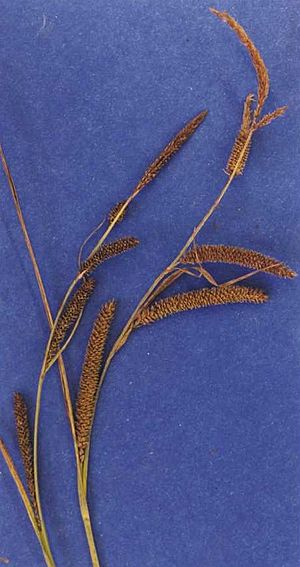Widefruit sedge facts for kids
Quick facts for kids Carex angustata |
|
|---|---|
 |
|
| Scientific classification | |
| Kingdom: | |
| (unranked): | |
| (unranked): | |
| (unranked): | |
| Order: | |
| Family: | |
| Genus: | |
| Species: |
C. angustata
|
| Binomial name | |
| Carex angustata Boott
|
|
| Synonyms | |
|
Carex egregia |
|
Carex angustata is a type of plant called a sedge. It's often known as the widefruit sedge because of its fruit. This plant grows naturally in the western parts of the United States, including states like Washington, Idaho, and California. You can usually find it in wet places, like damp meadows or along the edges of streams.
About Widefruit Sedge
The widefruit sedge is special because of how it grows. Unlike many other sedges that form clumps, Carex angustata spreads out. It does this using a large network of underground stems called rhizomes. These rhizomes help the plant grow and spread without forming tight bunches.
What it Looks Like
The stems of the widefruit sedge can grow quite tall, reaching up to about one meter (which is about 3 feet). Its leaves are long and narrow, and they feel a bit rough to the touch.
Flowers and Fruit
The plant produces flower clusters called an inflorescence. These clusters have different types of spikes. There are a few spikes with female flowers (called pistillate spikes). There are also one or two spikes with male flowers (called staminate spikes). Each of these spikes is a few centimeters long.
The female flowers have dark-colored bracts. Bracts are like small, leaf-like structures that grow near the flowers. After the flowers are pollinated, the plant produces fruit. Each fruit is covered by a special sac called a perigynium. This sac is usually 2 or 3 millimeters long. It has veins and can feel a bit bumpy. The perigynium is often green or light brown, and sometimes it has small red or purple spots.
See also
 In Spanish: Carex angustata para niños
In Spanish: Carex angustata para niños

